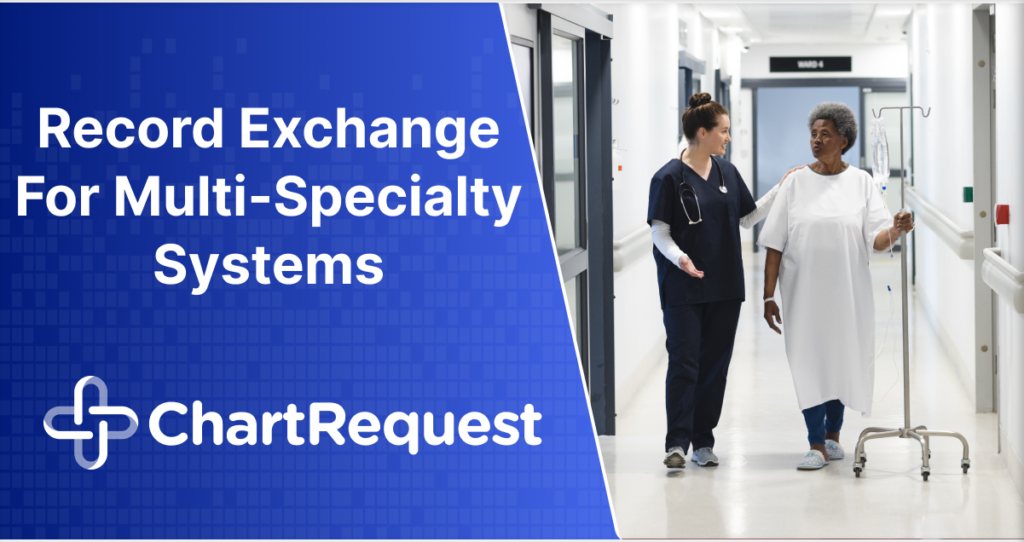Are you hoping to improve the release of information in 2024? As healthcare providers, it is understandable that your main focus is providing quality care to your patients. However, the administrative aspect of releasing medical records should not be overlooked.
With the ever-growing importance of care coordination in the healthcare industry, providers must have a faster, safer, and highly compliant release of information in 2024. Now more than ever, patients have become increasingly involved in their healthcare decisions and want quick access to their medical records.
Additionally, with the rise of electronic health records (EHRs), patients expect a seamless and secure process when requesting or transferring their medical information.
In this article, discover the top three ways to step up your Release of Information in 2024 and improve patient satisfaction.
The Evolution of ROI
Releasing medical records has come a long way since its inception. Traditionally, healthcare providers would manually handle requests by photocopying paper records and mailing them to the requesting party. This manual process was time-consuming and prone to errors and security breaches.
However, with the introduction of EHRs, the release of medical records has become more streamlined. Healthcare providers can now electronically store and transfer patient information, making fulfilling requests promptly and efficiently easier.
In recent years, there has been an increasing demand for online access to medical records through patient portals. This gives patients more control over their health information and reduces the burden on healthcare providers in managing and fulfilling ROI requests.
This framework for improving the release of information in 2024 is thanks to several key legislations that vigorously promote patient rights to medical records such as:
- HIPAA: The 1996 Health Insurance Portability and Accountability Act (HIPAA) requires healthcare providers to give patients access to their medical records upon request.
- HITECH Act: The 2009 Health Information Technology for Economic and Clinical Health (HITECH) Act reinforces HIPAA’s privacy and security rules, specifically regarding electronic health information.
- 21st Century Cures Act: The 2016 law introduces new provisions to make it easier for patients to access and share their health information, including through APIs (application programming interfaces).
- Right of Access Initiative: In 2019, the U.S. Department of Health and Human Services (HHS) released a set of guidelines that enforce patients’ rights to access their medical information in a timely and affordable manner.
Grossly violating any of these regulations can have dire consequences for your practices. In September 2019, Bayfront Health St. Petersburg violated the Right of Access Initiative and was fined $85,000 by the Office of Civil Rights (OCR).
Top 3 Ways to Step Up Your Release of Information in 2024
The world is increasingly becoming digital. With it comes the demand for faster, more secure, and accessible communication. The healthcare sector is no exception.
Here are the top three ways you can improve your Release of Information in 2024:
1. Eliminate Status Calls
In ROI, status calls refer to the inbound calls healthcare providers receive from requestors. These calls are usually inquiries about the status of their medical records requests. A high number of status calls can impact patient experience negatively. They can lead to frustration due to long wait times, repeated calls for updates, and potential miscommunication.
Furthermore, such calls can strain healthcare providers’ resources. It diverts staff from their primary roles in patient care to manage administrative tasks.
According to a 2022 survey, 90% of their respondents have used their online access to view test results. This number is only expected to increase in 2024.
To reduce status calls, consider implementing best practices:
- Implementing a Transparent ROI Process: Clear communication about the process and timeline of releasing medical records can significantly minimize status calls. Inform patients about the expected wait times and any potential delays beforehand.
- Enhancing Training for Staff: Ensure that your staff is adequately trained to handle ROI requests efficiently and professionally. This includes understanding how to use technology to process requests and how to handle frustrated patients.
- Automating Updates: Consider automating status updates or notifications via email or SMS so patients can be informed about the progress of their requests without having to make a call.
- Consistent Review and Improvement: Regularly review your ROI processes to identify areas of improvement. Implement changes promptly and communicate these improvements to patients to maintain trust and satisfaction.
Reducing status calls can provide several benefits such as:
- Enhance patient satisfaction by minimizing wait times and eliminating the need for repeated follow-ups.
- Free up healthcare staff to focus on core patient care tasks rather than administrative responsibilities.
- Increase operational efficiency by streamlining the ROI process.
- Leverage modern technology for higher transparency and better communication.
- Foster trust and credibility by showcasing an efficient and professional approach towards ROI.
2. Be More Attentive to Patients
In 2024, a patient-centric ROI process will be even more important in healthcare. There is an even bigger emphasis on accelerated access to medical records, while also enhancing patient trust and satisfaction.
A slow ROI process can negatively impact a healthcare facility’s reputation in several ways:
- it can lead to patient frustration due to delayed access to critical health information,
- cause a perceived lack of transparency in the facility’s operations,
- and may potentially result in non-compliance with regulations, thereby instigating legal and financial consequences.
Nowadays, an irate patient can easily take to the internet and leave damaging reviews against a healthcare facility. This can be troublesome considering 77% of patients use online reviews as their first step in finding a new doctor.
Consider the following strategies for enhancing a patient-centric Release of Information in 2024:
- Digital Access to Records: Provide patients with digital access to their medical records, enabling them to view their health information anytime, anywhere. This could be achieved through a secure online patient portal.
- User-friendly Interfaces: Ensure your online platforms are easy to navigate, optimized for mobile devices, and user-friendly. This can help patients retrieve their records with ease and reduce frustrations.
- Prompt Response to Requests: Aim to respond to patients’ requests for medical records in a timely manner. This demonstrates respect for their needs and can significantly enhance patient satisfaction.
- Clear Communication: Maintain open and transparent communication with patients. Let them know the status of their requests, expected delivery times, and any potential issues that might arise.
- Robust Data Security: Protect patient data with state-of-the-art security measures. This not only ensures compliance with regulations but also builds patient trust.
- Patient Education: Educate patients about their rights to access their medical records, the process involved, and how they can make these requests. This facilitates a smoother ROI process and helps patients feel more in control of their healthcare.
- Feedback Mechanism: Implement a system for collecting patient feedback about your ROI process. Use this feedback to make continuous improvements and ensure your process is meeting patients’ expectations.
Incorporating these techniques into your ROI process can help you stay ahead of the curve in 2024, enhancing patient satisfaction and strengthening your reputation in the healthcare sector.
3: Reduce Turnaround Times
One of the biggest roadblocks requestors run into when obtaining medical records is the lengthy and sometimes uncertain turnaround time.
If you look at the reports, OCR has settled thousands of HIPAA violations relating to delayed medical records release. A good example is how Optimum Medical Care had to pay $160,000 and implement a corrective action plan for violating the Right of Access Initiative.
If you want to effectively cut your turnaround time and avoid Right of Access violation, you can implement the following strategies:
- Centralizing Records: Develop a centralized system to store and manage medical records. This greatly expedites the process of locating and retrieving specific patient data when a request is made.
- Implementing Electronic Health Records (EHRs): Transition from paper-based records to Electronic Health Records. EHRs streamline the process of information retrieval, thus significantly reducing turnaround times.
- Automating Processes: Automate as many steps as possible in the ROI process, from processing requests to delivering medical records. This eliminates manual bottlenecks and speeds up the overall process.
- Prioritizing Requests: Prioritize requests based on urgency and/or legal requirements. This helps you allocate resources more efficiently and ensures timely patient delivery of critical health information.
- Outsourcing ROI Needs: Consider outsourcing your ROI process to a specialized service provider. These providers have the resources, technology, and expertise to quickly and accurately handle record requests.
Follow these steps to decrease medical record request times and enhance patient satisfaction. Remember to review and improve your ROI process regularly to keep up with healthcare and technology changes.
Leveraging Electronic Solutions for the Release of Information in 2024
An electronic Release of Information solution refers to digital tools and platforms that automate and streamline the process of releasing patient health information. This technology simplifies the management and exchange of medical records, ensuring faster and more efficient responses to requests from patients, healthcare providers, or other authorized entities.
ROI solutions offer numerous benefits, including reduced turnaround times, enhanced data security, and improved compliance with regulations.
For instance, ChartRequest is a comprehensive electronic ROI service that enables healthcare organizations to efficiently and securely process requests, retrieve and transmit records, and track the entire process. ChartRequest is designed to be user-friendly, facilitating navigation of the ROI process for both healthcare providers and patients.
Benefits of ChartRequest:
- Centralized Management: ChartRequest centralizes medical record requests. This cuts down on status calls by keeping everyone informed in real-time.
- Efficient Workflow: The platform streamlines the ROI process. It speeds up responses to patient requests, shortening turnaround times.
- Easy-to-Use Interface: ChartRequest’s user-friendly design makes it easy for patients, improving their experience with ROI.
- Real-time Updates: The platform offers immediate updates on requests, reducing the need for status calls and adding transparency.
- Secure Data Handling: ChartRequest safeguards patient health information with strong security, ensuring a trustworthy ROI process.
- Detailed Audit Trails: The platform keeps thorough records of each request. This helps comply with laws and tracks medical record sharing.
- Cloud-Based Access: As a cloud solution, ChartRequest allows access to medical records from anywhere, focusing on patient needs.
- Digital Record Delivery: The service supports the digital transfer of records, making the process quicker and more secure, which cuts down on wait times.
- Automated Alerts: Patients automatically get notified when records are ready, removing the need for status calls.
- Adaptable to Demand: ChartRequest can handle any number of requests, maintaining efficiency and responsiveness at all scales.
- Full-service ROI: ChartRequest offers a Full-Service ROI solution. Our team of HIPAA-trained ROI experts takes care of all aspects of the ROI process so healthcare organizations can focus on their core responsibilities without compromising patient satisfaction.
ChartRequest offers flexibility to help support your ROI needs. Aside from full-service, we also empower healthcare providers who prefer to take control of their ROI process through our Self-Service partnership plan.
Bolster the Release of Information in 2024 With ChartRequest
As we look ahead to 2024, we see an evolving landscape with opportunities to revolutionize the healthcare Release of Information. Top among the strategies to achieve this is the adoption of Electronic ROI solutions.
Adapting to these changes is not just an option but a necessity for healthcare providers aiming to stay on top of their game. By embracing these technologies and strategies, we can envision a future where ROI processes are swift, secure, and seamless, ultimately leading to enhanced patient experiences and operational efficiency.
The Release of Information in 2024 and beyond is promising, but the conversation does not end here. If you’re keen to experience firsthand the benefits of automated and efficient ROI, we invite you to try ChartRequest.
With a 2-day average turnaround time and a 4.8 Google rating from over 700 satisfied users, ChartRequest is designed to revolutionize your ROI process in 2024.
Embrace the future of healthcare technology with ChartRequest, explore our solution today!









